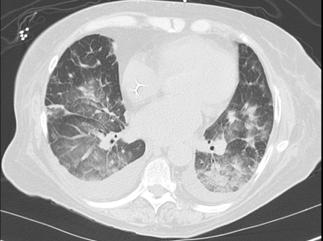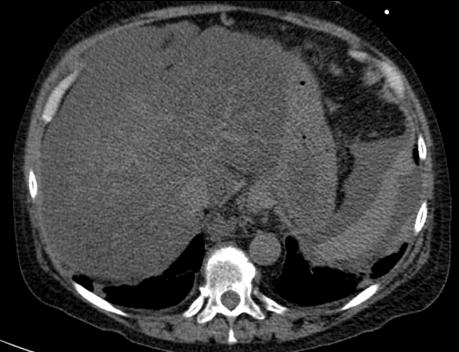Monday Poster Session
Category: Infections and Microbiome
P3492 - Aspergillus niger Peritonitis in Decompensated Cirrhosis Successfully Managed With Voriconazole
Monday, October 27, 2025
10:30 AM - 4:00 PM PDT
Location: Exhibit Hall

Faizan Ahmed, MD (he/him/his)
HCA Florida Healthcare
Clearwater, FL
Presenting Author(s)
Faizan Ahmed, MD1, Nimal Patel, DO1, Patrick Stocker, PhD2, Olugbenga Oyesanmi, MD2
1HCA Florida Healthcare, Clearwater, FL; 2HCA Florida Healthcare, Saint Petersburg, FL
Introduction: Fungal peritonitis (FP) causes 3–6% of peritonitis episodes and 20–30% mortality¹. Risk rises with prolonged broad-spectrum antibiotics that foster gut fungal overgrowth and with weakened peritoneal defenses in cirrhosis or peritoneal dialysis². Candida predominates, but molds such as Aspergillus can produce fulminant disease³. Voriconazole reaches high peritoneal levels without renal toxicity, suiting mold infections⁴. We report Aspergillus niger FP in a cirrhotic patient, underscoring diagnostic and therapeutic challenges.
Case Description/
Methods: A 58-year-old woman with atrial fibrillation, hypertrophic cardiomyopathy, alcoholic cirrhosis with portal hypertension, and chronic hypotension collapsed from syncope. She was hypotensive and bradycardic; the abdomen was distended with a fluid wave. Labs: creatinine 2.4mg/dL (baseline 0.8), bilirubin 4.1mg/dL, International Normalized Ratio (INR) 2.1, hemoglobin 8.1g/dL. Computed Tomography (CT) showed cirrhosis, moderate ascites, and a 3cm loculated collection by the distal esophagus. Paracentesis yielded cloudy fluid; analysis 1780cells/µL (85% neutrophils), serum–ascites albumin gradient 1.6g/dL. Ascitic cultures grew Aspergillus niger at 48h. Broad-spectrum antibiotics were stopped and IV micafungin 100mg/d begun. Persistent fever, leukocytosis, and positive cultures prompted escalation to IV voriconazole (6mg/kg q12h × 2, then 4mg/kg q12h). She deteriorated, required intubation and norepinephrine, and died after pulseless electrical-activity arrest.
Discussion: Aspergillus FP is rare outside peritoneal dialysis and highly lethal in cirrhosis, where immune dysfunction and portal-hypertensive translocation facilitate invasion¹. Early pathogen identification is vital because first-line fluconazole lacks mold activity. Amphotericin B is active but nephrotoxic—problematic in hepatorenal physiology. Voriconazole offers superior Aspergillus coverage, excellent bioavailability, and dialysate-to-plasma ratios ≈ 0.7, indicating good peritoneal penetration with renal safety⁴. Despite timely voriconazole, mortality rises once multiorgan failure occurs, as in this case. Earlier combined drainage of loculated ascites or expedited liver-transplant evaluation may improve outcomes. Prompt paracentesis with fungal culture, rapid mold-active therapy, and coordinated care among hepatology, infectious-disease, and critical-care teams remain essential to optimize survival.

Figure: Figure 1. Computed Tomography (CT) Chest showing small bilateral pleural effusions and extensive diffuse bilateral infiltrates.

Figure: Figure 2. Computed Tomography (CT) Abdomen/Pelvis showing severe hepatic steatosis suggestive of liver cirrhosis and portal hypertension.
Disclosures:
Faizan Ahmed indicated no relevant financial relationships.
Nimal Patel indicated no relevant financial relationships.
Patrick Stocker indicated no relevant financial relationships.
Olugbenga Oyesanmi indicated no relevant financial relationships.
Faizan Ahmed, MD1, Nimal Patel, DO1, Patrick Stocker, PhD2, Olugbenga Oyesanmi, MD2. P3492 - <i>Aspergillus niger</i> Peritonitis in Decompensated Cirrhosis Successfully Managed With Voriconazole, ACG 2025 Annual Scientific Meeting Abstracts. Phoenix, AZ: American College of Gastroenterology.
1HCA Florida Healthcare, Clearwater, FL; 2HCA Florida Healthcare, Saint Petersburg, FL
Introduction: Fungal peritonitis (FP) causes 3–6% of peritonitis episodes and 20–30% mortality¹. Risk rises with prolonged broad-spectrum antibiotics that foster gut fungal overgrowth and with weakened peritoneal defenses in cirrhosis or peritoneal dialysis². Candida predominates, but molds such as Aspergillus can produce fulminant disease³. Voriconazole reaches high peritoneal levels without renal toxicity, suiting mold infections⁴. We report Aspergillus niger FP in a cirrhotic patient, underscoring diagnostic and therapeutic challenges.
Case Description/
Methods: A 58-year-old woman with atrial fibrillation, hypertrophic cardiomyopathy, alcoholic cirrhosis with portal hypertension, and chronic hypotension collapsed from syncope. She was hypotensive and bradycardic; the abdomen was distended with a fluid wave. Labs: creatinine 2.4mg/dL (baseline 0.8), bilirubin 4.1mg/dL, International Normalized Ratio (INR) 2.1, hemoglobin 8.1g/dL. Computed Tomography (CT) showed cirrhosis, moderate ascites, and a 3cm loculated collection by the distal esophagus. Paracentesis yielded cloudy fluid; analysis 1780cells/µL (85% neutrophils), serum–ascites albumin gradient 1.6g/dL. Ascitic cultures grew Aspergillus niger at 48h. Broad-spectrum antibiotics were stopped and IV micafungin 100mg/d begun. Persistent fever, leukocytosis, and positive cultures prompted escalation to IV voriconazole (6mg/kg q12h × 2, then 4mg/kg q12h). She deteriorated, required intubation and norepinephrine, and died after pulseless electrical-activity arrest.
Discussion: Aspergillus FP is rare outside peritoneal dialysis and highly lethal in cirrhosis, where immune dysfunction and portal-hypertensive translocation facilitate invasion¹. Early pathogen identification is vital because first-line fluconazole lacks mold activity. Amphotericin B is active but nephrotoxic—problematic in hepatorenal physiology. Voriconazole offers superior Aspergillus coverage, excellent bioavailability, and dialysate-to-plasma ratios ≈ 0.7, indicating good peritoneal penetration with renal safety⁴. Despite timely voriconazole, mortality rises once multiorgan failure occurs, as in this case. Earlier combined drainage of loculated ascites or expedited liver-transplant evaluation may improve outcomes. Prompt paracentesis with fungal culture, rapid mold-active therapy, and coordinated care among hepatology, infectious-disease, and critical-care teams remain essential to optimize survival.

Figure: Figure 1. Computed Tomography (CT) Chest showing small bilateral pleural effusions and extensive diffuse bilateral infiltrates.

Figure: Figure 2. Computed Tomography (CT) Abdomen/Pelvis showing severe hepatic steatosis suggestive of liver cirrhosis and portal hypertension.
Disclosures:
Faizan Ahmed indicated no relevant financial relationships.
Nimal Patel indicated no relevant financial relationships.
Patrick Stocker indicated no relevant financial relationships.
Olugbenga Oyesanmi indicated no relevant financial relationships.
Faizan Ahmed, MD1, Nimal Patel, DO1, Patrick Stocker, PhD2, Olugbenga Oyesanmi, MD2. P3492 - <i>Aspergillus niger</i> Peritonitis in Decompensated Cirrhosis Successfully Managed With Voriconazole, ACG 2025 Annual Scientific Meeting Abstracts. Phoenix, AZ: American College of Gastroenterology.
